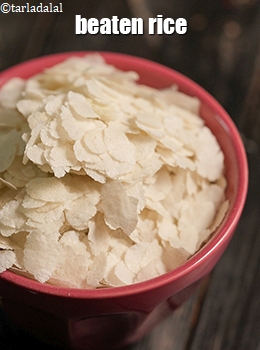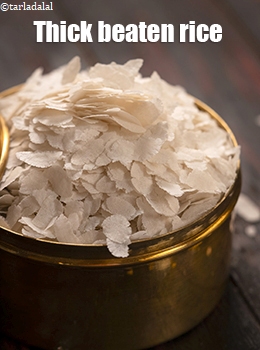beaten rice
Last Updated : Nov 12,2024
Poha, What is Poha? |How to use Poha in cooking? + Recipes with Poha
Viewed 242525 times

Also Known as
Poha, Powa, Flattened rice, Pressed rice, Flaked rice
What is Beaten Rice, Poha, Rice Flakes?
Poha is nothing but rice that has been parboiled, rolled, flattened and then dried to produce flakes. The flakes come in different thicknesses depending on the pressure used in the flattening process. Rice flakes are small, very light, about 2mm long, flat and greyish white in colour. They have uneven edges and a rough texture. Rice flakes have no particular aroma and a bland gentle taste. Depending on the method of cooking, they can be soft or crunchy.
The flakes are capable of absorbing a large volume of liquid when used in various recipes, and hence imbibe flavors well. They are very popular in Asian cooking, but in Western countries they are more often used commercially in the production of cereals and rice snacks.
Thick beaten rice

The rice flakes come in different thicknesses depending on the pressure used in the flattening process. Thick poha does not get mushy soon on soaking like the thin variety of poha. As per the recipe requirement you can toast, fry or soften the thick poha.
How to select Beaten Rice, Poha, Rice Flakes?
• Both medium and fine flakes are readily available in the market, so buy the one suitable for your recipe.
• Look inside the bag to make they are not too powdery, though some crumbling is inevitable.
How to use Beaten Rice, Poha, Rice Flakes?
• Rice flakes are very easy to cook and can make a meal in minutes. First wash the beaten rice in water and then soak for 10 minutes. Strain using a strainer and use as required to make sweet or savory snacks. Maharashtrians love Kanda Poha or Onion Poha and Quick Batata Poha
• Poha, made from rice flakes, is an easy-to-cook, light and nutritious snack that is often had for breakfast or brunch.
Poha is put in tea and then has as Tea Poha. Try it.
• During Ganesh Chaturthi, at midnight we put Poha in Milk and offer it to God as a Prasad or Bhog.
• When garnished with coconut, fresh tomatoes and cilantro, the vibrant red, green and white against the brilliant yellow of the turmeric-infused poha never fails to excite your taste buds. While poha tastes just as good with curds and pickles, you can add extra zing to it by serving with Mint-Coriander Chutney!
• Rice flakes can be used for preparing soft-cooked, energy-packed weaning food.
• It can also be toasted and seasoned to make chiwda. A jar full with Poha Chivda or Jada Poha Chivda
• Rice flakes are used to make creamy puddings and savory bakes too.
• Poha may be eaten raw like cereals, mixed with milk or yoghurt and fruit, or boiled like oatmeal.
• Poha is used by South Indians to make Idli & Dosa Batter, Idli and Dosa.
• Add poha to your gravies; it will act like corn flour to thicken the food.
• Poha patties can also be made by soaking poha and binding it with potatoes, chillies and coriander. Roast it or fry it, and enjoy with mint chutney or ketchup.
• An exquisite snack can be prepared by immersing the rice flakes in cold water, drying them, and then preparing it like a pulao with nuts, raisins, black pepper, green chillies, salt and sugar to taste.
• When one is down with fever or an upset tummy, some rice flakes can be immersed in bowl of water, flavoured with lime juice, salt, sugar and a little black pepper, to make a comfort food.
• Beaten rice can be used to make a variant of the famous ‘curd rice’ or ‘bagala bath’ so popular in south India. Soak the beaten rice in water and drain. Mix curd and salt to it, and serve with mango or lime pickle.
• Raw or slightly toasted beaten rice can be mixed with jaggery and grated coconut, allowed to stand for a few minutes (not more) to soak in the flavours, and then served. This is often made as a quick neivedhya, when no elaborate sweets or foods have been prepared for offering to God after puja.
How to store Beaten Rice, Poha, Rice Flakes?
• Store in a dry airtight jar, and use within three months.
Health Benefits of Poha, Beaten Rice, Rice Flakes
1. Plentiful of Carbohydrates : Most people prefer eating poha for breakfast. The reason behind it is its high carb count. A cup of poha provides approx. 46.3 gm of carbohydrates. A single serving is enough to satiate you and keep you full for hours.
2. Valuable Source of Iron : The high iron count (2.67 mg in a cup) of poha is because of its production process, which involves passing rice through rollers. The rice along with flattening out also retain some of the from these iron rollers. Iron is a key element in maintain the levels of hemoglobin and RBC (Red Blood Cell) count. To enhance the absorption of iron, you can simple squeeze some lemon juice on poha or accompany the delicacy made with beaten rice with a vitamin C rich fruit.
3. A Good Probiotic : Though surprising it may sound, but the during the process of soaking the grain undergoes a partial fermentation. This retains the probiotic bacteria which are beneficial for gut and assist in digestion.
For complete Health Benefits of Beaten Rice, Poha read this article.
Nutritional Value of Poha (beaten rice)
1 cup of poha is about 60 g
RDA stands for Recommended Daily Allowance.
Energy - 207 calories
Protein – 3.96 g
Carbohydrate – 46.3 g
Fat – 0.72 g
Fiber – 0.42 g
Vitamins:
0.12 mg of Vitamin B1 = 10% of RDA (about 1.2 to 1.6 mg for men)
0.03 mg of Vitamin B2 = 2.1% of RDA (about 1.4 to 1.9 mg for men)
2.4 mg of Vitamin B3 = 15% of RDA (about 16 to 21 mg for men)
Minerals:
60.6 mg of Magnesium = 13.57% of RDA (about 350 mg)
142.8 mg of Phosphorus = 6.25% of RDA (about 600 mg)
92.4 mg of Potassium = 5.13% of RDA (about 4700 g)
2.67 mg of Iron = 13.35% of RDA (about 20 mg for women)
10.9 mg of sodium

Soya

Missed out on our mailers?
Our mailers are now online!
View Mailer Archive
Privacy Policy: We never give away your email
REGISTER NOW If you are a new user.
Or Sign In here, if you are an existing member.

If your Gmail or Facebook email id is registered with Tarladalal.com, the accounts will be merged. If the respective id is not registered, a new Tarladalal.com account will be created.
Hi,

Click OK to sign out from tarladalal.
For security reasons (specially on shared computers), proceed to Google and sign out from your Google account.